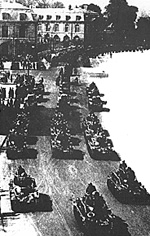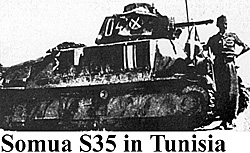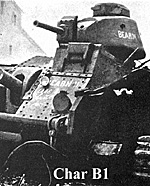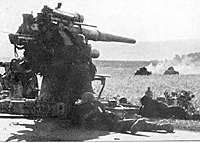 German tanks began to roll across theBelgian and
Luxembourg borderss on May 10, 1940. Six weeks later,
France lay prostrate, her army shattered, her allies
scattered. It was the beginning of the myth of German
armor invincibility.
German tanks began to roll across theBelgian and
Luxembourg borderss on May 10, 1940. Six weeks later,
France lay prostrate, her army shattered, her allies
scattered. It was the beginning of the myth of German
armor invincibility.
A closer examination of the campaign of 1940 reveals that France by herself had sufficient modern tank forces to defeat Germany. That such a lopsided victory ensued is not to fault the equipment or men of France's armor units. The "blame" lies with the French military readerships' inability to appreciate and properly utilize those forces available to them in 1940.
Development Prior to 1940
Ironically, France was one of the earliest exponents for tanks and armored forces. Great Britain and France were the first nations to use tanks in mass. Allied armored fighting vehicles (AFVs) tore gaps in the German trench lines and broke the four-year deadlock that characterized the First World War.
The tank was a revolutionary development in military technology. Despite the consequences it foreshadowed for future wars, very few military men of either the Allied or German armies appreciated the potential of the tank. Anti-military attitudes, the economic depression, and lack of foresight found the French army in 1936 still equipped with the FT-17, the same main battle tank it had used in World War I.
There were individuals in France who saw a future for mechanized armies. De Gaulle took up the cause first espoused by Camon and Allehaut in the late 1920s, and recommended a professional armored force of 100,000 men. His friend in the Chamber of Deputies, Reynaud, pushed for the professional, rather than mass conscript, army. But it was to no avail. France's political and economic crisis and its conservative military all hindered development of a trained armored force.
Only the growing threat of Nazi Germany spurred on a rapid increase and modernization of the French tank forces. 40 modern tanks were on hand in 1936. By 1939 over 2,200 new tanks had come off the assembly lines. A total of 3,500 tanks were completed by May, 1940. Of this number, 800 were medium or heavy types -- char B 1 bis or Somua S35 models -- the best tanks of any combatant in 1940. This phenomenal growth of French armor is even more remarkable when one considers the vast sums and priority given to the Maginot Line of fortifications and the production delays caused by the nationalization of France's industries.
Organization and Equipment
The French army experimented with its cavalry divisions in 1932, and these trials led to the establishment of the DIVISION LEGERE MECANIQUE (DLM), or Light Mechanized Division. The 1st and 2nd DLMs were formed in late August, 1939. The 3rd DLM didn't come into being until Febrttary of 1940. These units would prove to be the equal of any German panzer division, but the three DLMs would be wasted by being employed in the classic role of cavalry: screening the vulnerable infantry units.
The other French armored division, the DIVISION CUIRASSEE (DCR), was an offshoot of the 1st Groupement Cuirassee. The 1st G.C. was the main tank component of the French army at the beginning of the war. It was split to form the first and second DCRs in January, 1940. The 3rd DCR was created just prior to the German invasion, in March of 1940. De Gaulle's 4th DCR came in during the course of the campaign on May 15.
The battalion was the basic tank unit in the French army. Of the total of 68 tank battalions available on May 10, 1940, only 30 were organized within the DLMs and DCRs. The remainder were independent units attached to the nine French armies in Metropolitan France. The independent battalions contained mostly obsolete or obsolescent chars. The DLMs and DCRs were equipped with the best French tanks: Somua S35; char B1 bis; Hotchkiss H39; and Renault R35 models. The DLM and DCR establishment strengths for these tracked AFVs on May 10, 1940, were 261, 311, 591, and 135 vehicles, respectively.
Thus, the seven French armored divisions that took part in the campaign (DCRs 1, 2, 3, and 4; DLMs 1, 2, and 3) fielded 1,298 modem tanks as opposed to the German ten panzer divisions' establishment of 2,683 tanks. However, of the German total, only 822 were of modern Panzer III and IV models. The bulk of the German armored force -- Panzer I and II types -- were of no use against French tanks as they only mounted light machine guns or 20mm cannon and had very thin armor protection.
"Cavalry" armored vehicles within the DLMs consisted of automitrailleuses ("Machine gun cars") which had been developed in three categories: A.M.D. (decouverte) for distant or strategic reconnaissance with fast, wheeled vehicles having a wide radius of action; A.M.R. for local reconnaissance; and A.M.C. (combat) which included the powerful Somua S35 and light Hotchkiss H39 tanks. The DLMs were part of the cavalry arm of the French army. The DCRs with their char B1 bis, Hotchkiss H39, and Renault R35 tanks, and the independent battalions separated between the various armies, were part of the infantry.
 All tanks of the period, French, German, British, suffered frequent mechanical breakdowns. More tanks were lost in this manner in the campaign than in all the combat during the six weeks from May 10 -- June 26. However, while the Germans enjoyed the advantage of an excellent tank recovery system, the French often had to abandon and burn their vehicles that broke down.
All tanks of the period, French, German, British, suffered frequent mechanical breakdowns. More tanks were lost in this manner in the campaign than in all the combat during the six weeks from May 10 -- June 26. However, while the Germans enjoyed the advantage of an excellent tank recovery system, the French often had to abandon and burn their vehicles that broke down.
Campaign History
The following section covers each French armored division's short life in the 1940 campaign. It is a classic example of the misuse of a powerful weapon through misunderstanding and short sightedness.
DCR 1
Originally to be used as a back-up force for the Dyle maneuver, General Bruneau's division was sent on May 11 to the First Army to cover the Gembloux Gap. It didn't arrive in the vicinity of Charleroi until the night of May 12 due to confused orders. The division had no armored command vehicles and of the few tanks with radios, it was found that radio contact could not be maintained long due to poor equipment.
Twenty-five miles south of Charleroi, Rommel's 7th Panzer Division was forming its bridgehead across the Meuse. However, DCR 1 remained inactive all of May 13, while only Rommel's infantry was across the river. By midnight, Bruneau received orders to move south to support the XI corps engaging Rommel. Bad staff work delayed the division's move until midday on May 14.
Rommel was still being resisted fiercely around Onhaye, and the quick arrival of DCR 1 could have tipped the scale of battle in favor of the French. But traveling the twenty miles to an assembly area near Florennes took seven hours because the roads were cluttered with fleeing troops and civilians. By then the tanks were short on fuel and couldn't be used that day.
The 25th B.C.C. of H39 tanks lost its way during the night and only B.C.C. 28 and 37 (char B1 bis) and B.C.C. 26 (H39) reached the assembly area. Fuel trucks were far to the rear and did not arrive that night. The divisional artillery, reinforced with an additional groupe, was sent to the rear, out of close-support range.
 On the morning of May 15 Rommel had his tanks
across the Meuse, and after a brief engagement at
Flavion DCR 1 was destroyed. The two battalions of
heavy char B tanks were caught refueling by a concentration of German panzers. A close, confused combat took place with most of the French tanks being abandoned and burned by their crews.
On the morning of May 15 Rommel had his tanks
across the Meuse, and after a brief engagement at
Flavion DCR 1 was destroyed. The two battalions of
heavy char B tanks were caught refueling by a concentration of German panzers. A close, confused combat took place with most of the French tanks being abandoned and burned by their crews.
At least one French company counter-attacked, with considerable success. The heavy char B was able to knock out any German tank that presented itself as a target. The Germans found their 37mm guns no match for the armor plating of the French tank and concentrated instead on the treads, thereby immobilizing the 32-ton vehicles. Then, at very close range, heavier guns would finish them off.
7th Panzer moved on around DCR 1 to continue its advance, and before Bruneau's division could extricate itself, 5th Panzer came in. By late afternoon only six char B and a few H39 tanks remained operational. The battalion of H39s which lost its way during the night remained intact within DCR 1. That night the division withdrew and lost more tanks to breakdowns, fuel shortage, and misdirections. By the morning of May 16, DCR 1 consisted of seventeen operational tanks.
Rommel ran into the remnants of DCR 1 at Avesnes on the night of May 17. Hoping to surprise his way through the town in a bold night attack, his advance column of panzers was split by French tanks and several were destroyed. But again numbers proved to be in the Germans' favor, and only three French tanks escaped. Bruneau was captured the next day after dissolving his staff, and the divisional artillery was mopped up by the advancing panzer columns -- only one battery had ever engaged in combat.
DCR 2
On May 10, General Bruche's DCR 2 was located in the Champagne area with its sister divisions DCR 1 and 3. Most of the Hotchkiss tanks of B.C.C. 14 and 27 had the short-barreled 37mm gun. But B.C.C. 8 and 15 were complete and up to strength with char B heavy tanks. The division had been earmarked by General Georges to reinforce the &coed Army along with DCR 3. But it was seemingly forgotten until the afternoon of May 13 when it was dispatched on the heels of DCR 1 to Charleroi: away from Sedan and the main danger of Guderian's motorized corps already across the Meuse.
A shortage of tank transporters forced all tracked vehicles to move by train on flatcars. The wheeled transport of the division took to the roads.
However, DCR 1 had taken up most of the available flatcars with its move north, and DCR 2 was still loading at Chalons station on the morning of May 15, hindered by repeated German bombing attacks. This left DCR 2 scattered over a wide area behind the Oise, as separated trainloads of tanks moved north. Bruche did not even know where his units were on May 14.
Unknowingly, Kempf's 6th Panzer Division (part of Reinhardt's XLI Motorized Corps) cut DCR 2 in half on May 15 while moving through Signy on the way to Montcomet. One artillery battery on the road was overrun, another just disappeared. The columns that had moved on by road were forced back southwards by 6th Panzer. On May 16 the armored elements of DCR 2 lay scattered over the area between St. Quentin and Hirson. This put the tanks on the north side of 6th Panzer's thrust and without supply or support from the rest of the division which was south of the Aisne.
Communications in such a rapid moving campaign were vital, yet General Georges did not learn about the fate of DCR 2 immediately. Consequently, operations with non-existent divisions were still being planned. A counter attack was ordered for May 17 using DCR 1 and 2 striking from the northem side of von Kleist's panzer bulge, while de Gaulle,s DCR 4 would attack from the south. But there no longer was a DCR 1 and DCR2 was a division without a commander. Bruche's armor had been scattered in a wide area behind the Oise and no regroupment of the battalions was undertaken. Indeed, the tanks were further dispersed to cover the river crossings.
In the defense of these crossings the heavy French tanks were often quite successful. Three char Bs at Rethel on the Aisne shot up all approaching German columns from May 16 to May 20. But such piecemeal action was a waste of France's vital counter-strike force. Between May 13 and May 20, DCR 2 lost 54 Hotchkiss and 45 char B tanks in small separated units.
DCR 3
General Brocard's DCR 3 only started divisional training north of Reims on May 1, and was short one company in the light 42nd B.C.C. (H39). The French saw the threat developing in the Ardennes as early as May 11, and DCR 3, along with DCR 2, was to initially back up the Second Army behind Sedan. But the reaction time between General Georges' orders to move on May 12 and the forty mile advance north was extremely slow. Bombed roads, refugees, and a lack of artillery tractors and radios helped to delay the advance, DCR 3 finally reaching its assembly area behind Stonne on May 14.
Slow refueling and contradictory orders threw away an opportunity for an immediate counter attack in conjunction with Second Army's 4th and 7th independent tank battalions. And then French faith in the 1918 principle of containment led to the loss of DCR 3 as a division. During the night of May 14, heavy B.C.C. 41 and 49, and light B.C.C. 42 and 45 were broken up into small sections of one heavy char B and two light H39 tanks to cover the twelve miles from Omont to Stonne. As soon as Georges learned of this dispersal, he angrily ordered an immediate counter attack for the next day. The 49th B.C.C. of char B1 bis and a handful of H39 tanks were all that could be mustered.
They struck Stonne in conjunction with some infantry early on May 15, where Grossdeutschland Motorized Infantry Regiment had advanced to. Heavy losses on both sides and excellent French fighting highlighted the ten hour, point-blank duel. Brocard's tanks versus a German 37mm anti-tank gun company and some self-propelled infantry guns gave more than they received. Grossdeutschland was badly shaken, and the German command at higher levels was very nervous about the attack. But Stonne had held (there was no French infantry to consolidate the gains) and Grossdeutschland was pulled out for a needed rest. The bulk of DCR 3 wasn't even involved in the nearly successful attack, and it continued to operate in small packets along the Ardennes Canal.
DCR 4
On May 17, the day the advancing panzer columns were ordered to halt, General Georges called for a counter attack on the German armor bulge. In order to gain time for General Touchon's new army forming to cover Paris, Colonel de Gaulle's DCR 4 was to attack the southern flank of the German forces -- specifically Guderian's motorized corps.
DCR 4 had been in the process of formation when the Germans opened their offensive on May 10. The normal establishment of char B tanks (B.C.C. 46 and 47) was supplemented with Renault R35 tanks (B.C.C. 2, 24, and 44) instead of H39 models, and an additional B.C.C. (19th) and company (345th) of D2 tanks were added. De Gaulle had just accepted command of the division on May 11, turning down a political position with the War Cabinet. Only part of the armored forces were assembled by May 17, reinforced by a groupement from the 3rd Light Cavalry Division.
The attack could be little more than an armored raid, since only a battalion of infantry was with the divisor as support. From an assembly area near Laon, one column comprising a battalion of heavy char Bs and a company of D2 tanks was to strike twenty miles northeast towards Montcornet.
The other column, heading for Lislet, consisted of two battalions of R35 tanks, mounting the low-velocity 37mm gun. The tanks swept down the roads, overruning a German reconnaissance column and other motorized transport strung out over the extended flank. By afternoon the important road junction at Montcornet was reached. An ad hoc defense thrown together personally by the commander of the 1st Panzer Division, General Kirchner, stopped the French tanks. Then fuel shortage forced a withdrawal, impeded by Stukas.
The other column of de Gaulle's tanks had been stopped dead at the river Serre by German self-propelled guns.
On May 19 another attack was planned, this one striking from the vicinity of Laon towards Crecy-sur-Serre. It was reinforced with newly-arrived cavalry tank units, but the Germans were protecting their exposed flank more carefully now, and threw de Gaulle back again with heavy losses. DCR 4 was used once again in the counter attack role when on May 29 and 30 it struck the German bridgehead across the Somme in the area around Abbeville. Lack of infantry again prevented consolidation of gains by the armor, and well-placed German anti-tank guns accounted for many of de Gaulle's tank losses. By June 5 the division had a total of 73 AFVs -- down from a peak establishment of over 350 vehicles.
Cavalry Corps
General Prioux's Cavalry Corps was France's only completely mechanized corps. DLM 2 (8th reconnaissance and 13th and 29th combat regiments) and DLM 3 (12th reconnaissance and 1st and 2nd combat regiments) were deployed between Cambrai and Hirson on May 10. DLM 1 was detached from the corps, assigned to Giraud's 7th Army for the Breda maneuver in the move to assist Holland.
Orders were received to execute the Dyle maneuver as soon as the German attack was discovered. DLM 3 moved from Cambrai and Le Cateau to Wavre and Cortil-Noirmont in Belgium, while DLM 2 advanced from Le Nouvion to Gembloux and Namur. DLM 1 (6th reconnaissance and 4th and 18th combat regiments) moved up rapidly from Etaples to Turnhout. The divisions advanced in daylight unhampered by German aircraft, as the Luftwaffe was busy airlanding troops in Holland, covering the advancing panzer columns in the Ardennes, and concentrating its attacks on Allied airfields.
Enemy contact was made on May 12 as DLM 2 and 3 performed their reconnaissance sorties between Huy and Tongres. They were now being harassed by aircraft which impeded their movements. On May 13 an attack was launched in which the tanks separated themselves from their anti-tank guns and infantry support units. The German 3rd and 4th Panzer Divisions usually tried to avoid the superior French tanks and go for the isolated guns and infantry. Constant Stuka attacks took heavy toll of French AFVs. Each side lost about 80 tanks in the battle near Hannut, neither side coming out with an advantage over the other at the end of the day.
The French were content to have delayed the panzers and kept them from the 1st Army along the Dyle River. From now until the evacuation at Dunkerque, DLMs 2 and 3 would be in a running battle with the German advancing columns. By the time the corps reached the Escaut line back in France, joined by DLM 1, the divisions would be greatly reduced in strength, DLM 3 nearly down to half its original complement.
All through the important days of May 14 - 18 while the DCRs were being destroyed, the Cavalry Corps performed only limited reconnaissance missions. The most potent, concentrated armor force the French now had was not used against the vulnerable German flanks. Instead, many tanks were being needlessly lost to mechanical breakdowns and not recovered because of the retreat.
After the German panzers reached the Channel coast above Abbeville on May 20, the DLMs were finally used aggressively, if separately. DLM 3 covered the right flank of the British 1st Armored Brigade's attack through Arras on May 21. Weygand, the new Allied commander-in-chief, called for a major counter attack towards the Somme, in order to save some of the divisions encircled by the German pincer.
But the demoralized French and British commanders in the northern pocket did not press beyond a few miles south and west of Arras. Despite the ease of penetration with their heavy tanks, the Allies did not follow up the success achieved against Rommel's 7th Panzer, and the SS Totenkopf Motorized Division, both of which were badly mauled in the action around Arras.
 On May 22 DLM 2 made a reconnaissance in force towards Cambrai and was only stopped when it ran into heavy 88mm anti-aircraft guns forced to act in an anti-tank role. Both of these actions shook the German High Command and contributed to the decision to halt the panzer divisions on May 24 along the canal line short of Dunkerque.
On May 22 DLM 2 made a reconnaissance in force towards Cambrai and was only stopped when it ran into heavy 88mm anti-aircraft guns forced to act in an anti-tank role. Both of these actions shook the German High Command and contributed to the decision to halt the panzer divisions on May 24 along the canal line short of Dunkerque.
After providing cover for the gradual withdrawal of Allied forces to the Dunkerque area, DLMs 1, 2, and 3 abandoned their remaining tanks and equipment and were evacuated to Portsmouth and Plymouth on May 31. They eventually returned to France via Cherbourg from June 1 -- 5, and partially regrouped and reequipped near Caen. But the Cavalry Corps was only a shadow of its former self, and could not influence the events now forcing the end of the French Third Republic.
Unable to think in what Liddell Hart described as "tank time," the French commanders from Army to Divisional level reacted too slowly or not at all to the German Blitzkrieg. While some individual tanks and small units fought quite well, the French army on the whole performed quite poorly. Faith in World War I techniques, rigid strategic thought, lack of adequate communication, and poor command structure resulted in the piecemeal destruction of France's armored forces.
More French Armored Divisions
-
French Armored Divisions
French Division Legere Mechanique
French Division Cuirassee
French Tanks and Specs
French Tank Commanders
Large Map of Armor Movements: May 10-17 (slow: 136K)
Jumbo Map of Armor Movements: May 10-17 (very slow: 211K)
Related
Back to Conflict Number 4 Table of Contents
Back to Conflict List of Issues
Back to MagWeb Master Magazine List
© Copyright 1998 by Dana Lombardy
This article appears in MagWeb (Magazine Web) on the Internet World Wide Web.
Other military history articles and gaming articles are available at http://www.magweb.com